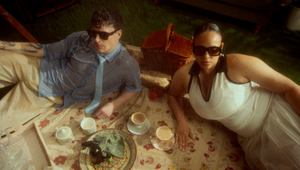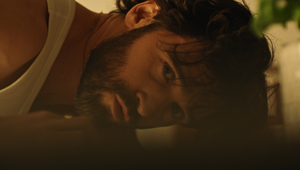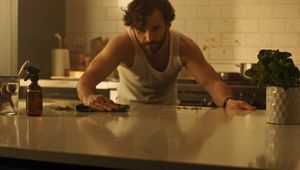
Could Advertising Soon Be More AI than Human?

Can you imagine the Demogorgon from Stranger Things playing basketball? An AI can picture it quite capably these days, as many on social media have recently discovered.
In fact, the internet has been awash with AI-generated artwork in recent weeks, with platforms like Dall-E and Midjourney filling our feeds with nightmare fuel.
Ad agency 10 Days has been watching this sudden proliferation of ways to make fast AI-generated imagery with excitement. So they put it to work to reimagine ads for 10 iconic brands, from Nespresso to KFC to Wimbledon, entirely using a powerful AI. The ‘Ad Intelligence’ project offers an exciting glimpse into the potential of AI-driven creative, with stunning and thought-provoking results.
The ads cover a spectrum of visual identities, spanning retro, cinematic, noir, and even cartoon styles. The images often feature familiar shapes, like the plane wing of a British Airways plane, or the signature nugget of KFC chicken; just as often, however, the shapes are unrecognisable computer imaginings which make the images surreal and wonderful, ranging from bright, kitsch colours to sci-fi, Dali-esque nightmares.
Florence Burdge spoke to 10 Days to find out more.

LBB> When did you become aware that AI-created adverts were a possibility, and what led to starting the project with Midjourney?
10 Days> In the art community there are lots of amazing artwork coming out of various AI platforms. But it was Midjourney that caught our attention.
We quickly noticed that no one was really exploring the potential for brands. At 10 Days, we’re always looking for ways to disrupt processes, and we wanted to see whether the AI art direction could match up or even challenge “human”-created work.
LBB> Can you give us an idea of how the program works, what prompts did you use and how this creates the final image?
10 Days> 10 Days ideated 24 times on each brand, with six prompts. Each piece of artwork is generated using simple, genre-based words, like ‘sci-fi’, ‘noir’ or ‘cinematic’. Incredibly, the entire process took just five minutes to churn out. And due to the ever-changing nature of AI-produced artwork, every image is one of a kind.

LBB> What were you expecting or hoping for when you chose the prompts, and what was your reaction to the final results?
10 Days> We wanted to keep the prompts to a minimum so it had maximum creative licence. We wanted to see what the AI was truly capable of. Our minds were blown that an algorithm can create such elegant, thought-provoking imagery. It has created a whole new genre of art and design. But it’s the speed that is quite remarkable – taking 60 seconds to create a set of four unique images – that got us really excited.
LBB> There is a very retro feel to many of the ads, which seems to contrast with the emphasis on AI and modern technology. Why did you choose these aesthetics?
10 Days> When AI thinks about a topic, it scours the whole internet for visual data to inform its choices. There happens to be a lot of readily available old-school ads on the internet, so certain retro themes emerge. A bit like when you mime a phone, you stretch your fingers to mimic one from the ‘80s. Or think of a TV as something with an aerial, not a flat rectangle. Same principle. It’s incredible to watch.

LBB> Some of the images created are very strange and unsettling. Was this an accidental result or intended? What changes need to be made for the program to be effective in mainstream media and advertising?
10 Days> We wanted to keep this project as pure as possible. The AI does have a tendency to make things weird and strange, so some of our keywords were adapted to counter this. We wanted to show the spectrum of results. And let’s face it – what is weird and unsettling to us is because it is unusual, it’s not what we expect. But to AI, perhaps this is what is normal, and we are just trying to manipulate how it generates images to suit our human tastes.
On the one hand, the algorithm needs to learn – to understand how to be directed with more precision. But on the other hand, by over-directing, the result is more human than AI, so you have less chance of creating something that is unique and outstanding.
LBB> For many people the growing power of AI is a frightening concept. What is your take on this issue and AI’s place in the creative industry?
10 Days> Intriguingly, the algorithm is constantly improving – and so the results you get are getting better and better. Once set on an idea, human creative minds often struggle to explore the edges of where an idea could go. AI can reach beyond those prejudices.
However, you still need a creative mind to inform the AI. You still need to nurture, interpret and build upon the ideas the AI creates. For advertising, the message you want to convey is very much in human hands. AI is a tool for expressing that.
For many, AI art direction will become as ubiquitous as using Adobe for design or Pinterest for inspiration. The rate that AI Creativity is developing, it won’t be long before advertising campaigns are more AI than human.
LBB> On a practical level, how do you plan to harness this program to benefit your agency? Is this something that can be implemented in the near future?
10 Days> Currently we are using AI as a tool for inspiration throughout the creative process. AI can create worlds and can articulate a collision of different ideas/thoughts creating completely unique imagery at incredible speeds, which can be harnessed by our creative teams. What used to take days or weeks can be created in under a minute.
In real terms, you have a unique member of your team – an AI art director – who is 100x faster, faff-free, and in many ways batshit crazy. They take considerably less holiday, too.

LBB> What is your vision for the future of this tech in advertising? Should there be limits placed on this kind of technology and what possible uses could it be put to in order to claim the greatest benefit?
10 Days> The future of advertising will be wherever technology opens up creativity. Anyone would be foolish not to see the potential in harnessing AI. But the ad industry surprisingly doesn’t cope well with change, and adores conventions. 10 Days was founded on the frustrations of ‘way things are done’ in this industry. To continually challenge conventions we use art and technology to explore the boundaries of the creative process. This leads us to discover new innovative ways to create better, more interesting work at record-breaking speeds. Ad Intelligence™ (AI) is a clear example of that.
Limits? Come on. This is a paradigm shift in creativity. We should be pushing the limits of all technology to make innovative and exciting work.
LBB> Finally, which of the finished images is your favourite or excited you the most?
10 Days> The first brand we tried was Nespresso and the results were stunning. They had an elegant compositional quality that really blew us away. Once the team saw these, we started to build momentum and try various different brands, all interesting and differing in their own design.
But the really wow moment came when we plugged in Gucci. The visuals that came from that got us beyond excited. The odd characters and the bold branding were like nothing we’d seen before. We knew then that we had created something pretty special. There was one image from Ray-Ban that looks like a Blade Runner collaboration with Lord of the Rings. We immediately printed it and framed it to have in our office because it is truly incredible.

Additional reporting by Alex Reeves.















